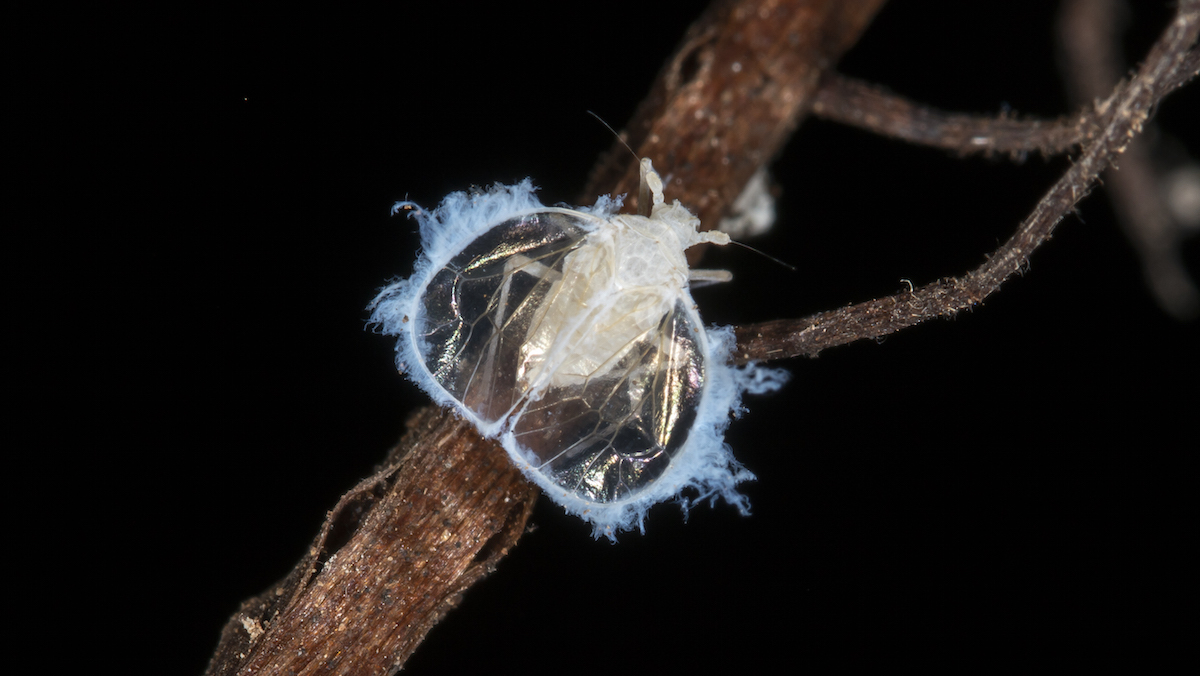An international study with the participation of the Natural History Museum (UV) has made the first record of a cave-dwelling Kinnaridae from the Old World. It is Valenciolenda fadaforesta, a species found in Valencian caves and a remnant of an ancient extinct fauna. The uniqueness of its characteristics makes it necessary to establish a new genus of Hemiptera. The work appears published in the journal Subterranean Biology.
It is, according to the article, it is a tiny creature of exceptional morphology, absence of eyes and ocelli, pale pigmentation and glassy wings bordered by a bright blue waxy hair in males, which evokes images of a fairy. Hence its name, Valenciolenda fadaforesta, the fairy of the Valencian forests, since the specimens studied were found in the natural reserves of the Sierra Calderona and Les Rodanes of Vilamarxant.
An international research team led by the Humboldt-University (Berlin, Germany), of which the biologist Sergio Montagud (Natural History Museum of the University of Valencia) is a member, has just provided a detailed description of the ecology, behaviour, distribution and state of conservation of this cave bug.
Like the rest of the hemiptera, the insects of this species feed on the sap of the plants and trees that they reach thanks to their beak or stiletto. In their case, they obtain it from the roots that penetrate to the caves. The nymphs, as usual, do not have wings. However, they are well developed by adults, which is in contrast to the underground type of life. “This is a very interesting species”, says Sergio Montagud. “Especially the males show very marked ornamentation, which has been observed in other cave species and whose function we do not know. We don’t think they can fly, but they are capable of considerable leaps and can use their wings to glide”, he says.
The registry of this ancestral hemiptera, whose characteristics make it unique enough to establish a new genus of hemiptera, is incorporated into the ZooBank and GenBank – international databases of zoological nomenclature and genetic sequences – to contribute new data to the study of underground biodiversity. Part of its importance lies in its exceptionality: it is the first record of a cave-dwelling kinnarid from the Old World; the first record also of a cave hemiptere from continental Spain, and it is the seventh species of cave kinnarid in the world.
The very absence of representatives of this family in continental Europe reinforces the biogeographical interest of this discovery. “Valenciolenda descends from a species that was once epigeal, that is, not underground, and that must have lived in an ecosystem and among a completely different fauna”, the biologist explains. “Those conditions changed and the current representatives of the family are distributed in remote areas. Valenciolenda adapted to the subterranean world as a survivor of that fauna that has now disappeared, just as there are other species of relict invertebrates in Valencian caves that tell us about those extinct pasts, such as the Ildobates neboti beetle”, he adds.
The unexpected discovery of Valenciolenda fadaforesta in an Iberian cave highlights the importance of underground biodiversity. The study of cave fauna can provide valuable information on the evolutionary and biogeographic history of organisms and their adaptations to the subterranean environment, but fundamentally it provides science with data on the composition of ecosystems in the past and on the development and evolution of biodiversity on Earth. “Along with fossils, cave-dwelling organisms are, today, our best window to the past”, Montagud concludes.
En el estudio han participado investigadores de la Humboldt-University (Berlin, Alemania), la Universitat de València, el Ajuntament de València y la Universidade Federal de Lavras (Minas Gerais, Brasil).
Reference:
First record of a cavernicolous Kinnaridae from the Old World /Hemiptera, Auchenorrhyncha, Fulgoromorpha, Kinnaridae, Adolendini) provides testimony of an ancient fauna. Hannelore Hoch, Alberto Sendra, Sergio Montagud, Santiago Teruel, Rodrigo Lopes Ferreira
https://subtbiol.pensoft.net/article/60483/


